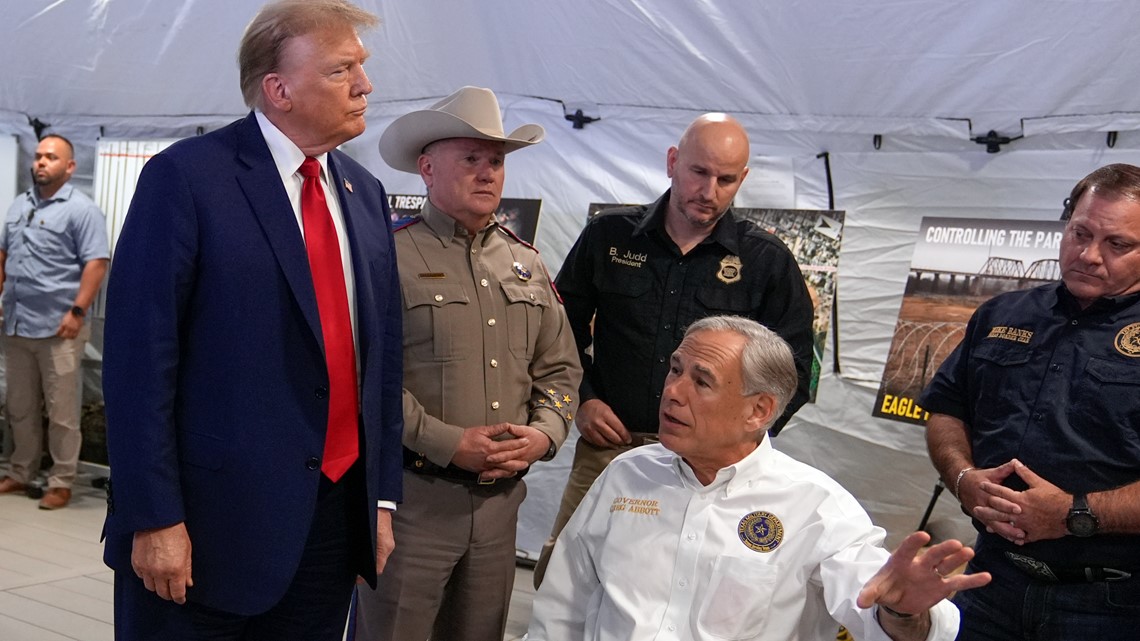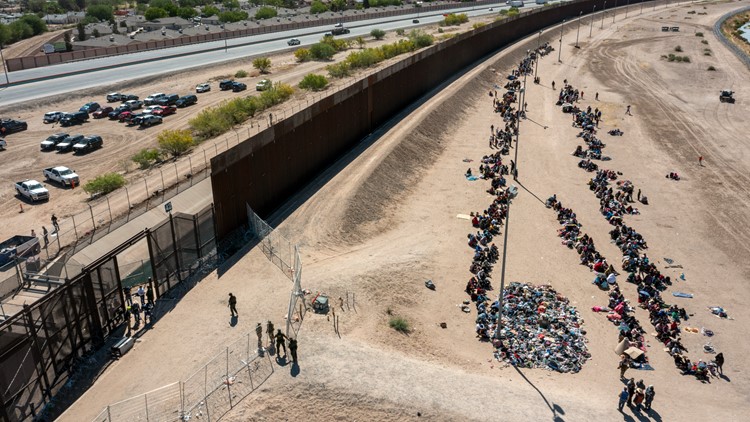To Gov. Greg Abbott, the results of his multibillion-dollar border security initiative are clear.
In a recent television interview, Abbott highlighted a decrease in the number of migrants trying to enter the country through the Rio Grande into Eagle Pass after he ordered the state National Guard to seize a 50-acre public park there. He also noted another statistic: Texas has more than two-thirds of the U.S.-Mexico border, but has recently seen fewer illegal crossings than other border states.
“We are having a profound impact in stopping the flow of illegal immigration into the state of Texas,” Abbott said in the interview, crediting Operation Lone Star, the border security initiative he launched in March 2021.
Federal statistics confirm Abbott’s claim that overall more migrants were encountered by Border Patrol agents outside of Texas each of the first three months of this year. During the 2023 fiscal year, Texas on average accounted for roughly 59% of migrant encounters along the southwest border. During the first half of the 2024 fiscal year, which began in October, Texas has on average accounted for 43% of migrant encounters.
However immigration and foreign policy experts say the reasons driving the recent shift — and any migration patterns changes in general — are much more complicated. And they said the numbers are likely to change again if history offers any clues.
“He can, with no evidence and no real deep analysis, claim all the credit he wants to — and good for him,” said Tony Payan, director of the Center for the United States and Mexico at the Baker Institute, a nonpartisan policy research organization based at Rice University in Houston. “But those of us who have been looking at immigration for a long time would probably be a lot more skeptical.”


The number of migrants trying to enter the country illegally in between legal ports of entry reached historic levels in the wake of the coronavirus pandemic. U.S. Customs and Border Protection reported a record 2.4 million migrant apprehensions at the nation’s southwestern border for the fiscal year that ended in September 2022.
Texas shares about 1,250 miles of border with Mexico and is home to five of the nine Border Patrol sectors along the southern border — the El Paso Sector also includes New Mexico’s 180 miles of the border. Since at least 2019, Border Patrol agents in the Texas sectors have recorded more encounters with migrants each month than the rest of the sectors.
Until last fall.
In November, non-Texas sectors recorded roughly 104,000 migrant encounters compared to about 87,000 recorded in Texas’ five sectors. Texas saw more encounters in December than the other states, but the trend flipped back again in January, when Border Patrol agents in Texas encountered fewer migrants than agents elsewhere along the southern border, according to Border Patrol figures.
The biggest decrease in encounters occurred in the Del Rio sector, which includes Eagle Pass, where agents recorded more than 70,000 migrant encounters in December compared to fewer than 20,000 in each of the first months of 2024, according to Border Patrol figures. Meanwhile, the San Diego and Tucson sectors have recorded consistent increases since last summer until recent tiny dips.
More border encounters are now being reported outside Texas
The five Border Patrol sectors in Texas historically recorded more migrant encounters than the four sectors in other states along the U.S.-Mexico border. That trend shifted in November 2023 when non-Texas sectors recorded more than 100,000 encounters. So far in 2024, each month has seen more encounters in the non-Texas sectors.
The recent trend comes three years after Abbott began flooding the Texas-Mexico border with state troopers and National Guard soldiers through Operation Lone Star.
Since then, the state has allocated more than $11 billion of taxpayer money for Operation Lone Star, said gubernatorial spokesperson Andrew Mahaleris. That money has also paid for the transporting of more than 100,000 migrants to cities like New York and Chicago, placing 70,000 rolls of concertina wire along the border, and beginning construction on a military base that may reportedly cost more than $400 million.
“The vast majority of the United States' southern border is in Texas, and because of Texas' efforts to secure the border, more migrants are moving west to illegally cross the border into other states,” Mahaleris said in a statement. “Until President Biden steps up and does his job to secure the border, Texas will continue utilizing every tool and strategy to respond to this Biden-made crisis.”


Immigration experts say it’s difficult to measure the impact of Texas’ border buildup because it’s just one piece of a complex, global phenomenon — migration is increasing around the world. In countries like Honduras and Venezuela, poverty, lack of jobs, political instability and organized crime have pushed people toward the U.S. to seek a better life. That often means paying smugglers and cartels who often change their smuggling routes.
“We’ve always treated the border as a simple line on a map, but it’s more than that — it’s an ecosystem,” said Victor M. Manjarrez Jr., who worked for the Border Patrol for 22 years and retired as the Tucson Sector chief in 2011. “An ecosystem that is impacted by variables very close and very far, and very far is also outside the U.S., right? It’s not only Mexico, but you’re talking about other countries.”
Mexico has in recent months increased its enforcement efforts by arresting or detaining more migrants from other countries, said Adam Isacson, director for defense oversight at the Washington Office on Latin America, an advocacy group for human rights in the Americas. But Mexican statistics indicate that the country is not deporting people and recent court decisions have ruled that migrants can’t be detained for more than 36 hours for the most part, he said.
“They’re just massively putting people on buses, it seems, and sending them to the southern part of the country and the central part and almost anywhere else that’s not near the [U.S.] border in order to try to depressurize the border,” Isacson said. “It’s very confusing and murky but they are stopping a lot of people.”
It’s also possible that Senate Bill 4, Texas’ new immigration law that would let state police arrest people suspected of entering the country illegally, is causing a “wait and see” moment that typically accompanies any new immigration policy, Isacson said. The law remains locked in unresolved court challenges and is not currently in effect.
“If the courts allow SB 4 to go forward, the numbers might drop even more,” Isacson said. “But then they will come back. … Migrants will realize that ultimately it’s just another speed bump.”


Some immigration policy experts credit the Biden administration for the recent decrease, pointing to a winter visit from top U.S. officials — including Secretary of State Antony Blinken and Secretary of Homeland Security Alejandro Mayorkas — to Mexico to discuss immigration with their Mexican counterparts. Top American and Mexican officials have touted agreements from such closed-door meetings.
Immigration experts pointed out that apprehensions at the U.S.-Mexico border dropped during the first three months of the year — a period that would typically see an increase as migrants try to make the journey before the summer heat arrives.
Another major change last year was the expiration of Title 42, a policy launched by the Trump administration at the beginning of the COVID-19 pandemic that allowed U.S. border officials to quickly remove migrants to Mexico without allowing them to claim asylum.
Many of those migrants would try crossing again — and each time they were apprehended counted as an encounter, which pushed up the number of encounters, said Guadalupe Correa-Cabrera, a professor at George Mason University who has researched the border and U.S.-Mexico relations.
Migrant encounters decreased immediately after the end of Title 42, according to Border Patrol data, but increased again near the end of 2023.
“How are we going to attribute the increase or decrease to either Border Patrol or to Operation Lone Star?” Correa-Cabrera said. “It’s difficult. It’s impossible to know that.”
The Texas Tribune is a nonprofit, nonpartisan media organization that informs Texans — and engages with them — about public policy, politics, government and statewide issues.
>MORE BORDER COVERAGE:



